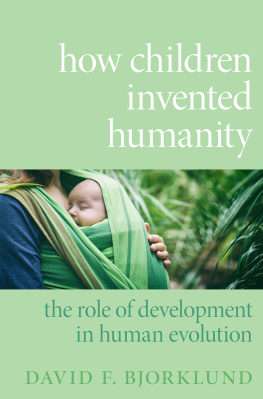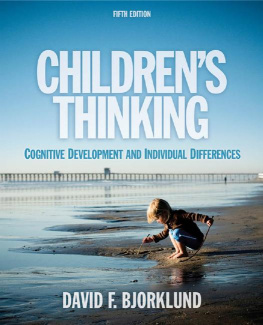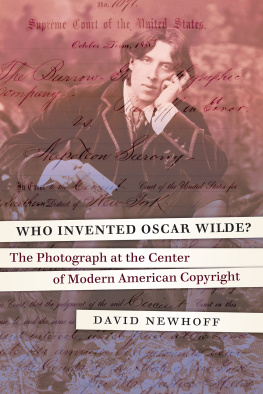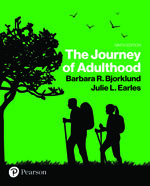David F. Bjorklund - How Children Invented Humanity
Here you can read online David F. Bjorklund - How Children Invented Humanity full text of the book (entire story) in english for free. Download pdf and epub, get meaning, cover and reviews about this ebook. year: 2020, publisher: Oxford University Press, genre: Home and family. Description of the work, (preface) as well as reviews are available. Best literature library LitArk.com created for fans of good reading and offers a wide selection of genres:
Romance novel
Science fiction
Adventure
Detective
Science
History
Home and family
Prose
Art
Politics
Computer
Non-fiction
Religion
Business
Children
Humor
Choose a favorite category and find really read worthwhile books. Enjoy immersion in the world of imagination, feel the emotions of the characters or learn something new for yourself, make an fascinating discovery.
- Book:How Children Invented Humanity
- Author:
- Publisher:Oxford University Press
- Genre:
- Year:2020
- Rating:4 / 5
- Favourites:Add to favourites
- Your mark:
- 80
- 1
- 2
- 3
- 4
- 5
How Children Invented Humanity: summary, description and annotation
We offer to read an annotation, description, summary or preface (depends on what the author of the book "How Children Invented Humanity" wrote himself). If you haven't found the necessary information about the book — write in the comments, we will try to find it.
How Children Invented Humanity — read online for free the complete book (whole text) full work
Below is the text of the book, divided by pages. System saving the place of the last page read, allows you to conveniently read the book "How Children Invented Humanity" online for free, without having to search again every time where you left off. Put a bookmark, and you can go to the page where you finished reading at any time.
Font size:
Interval:
Bookmark:


Oxford University Press is a department of the University of Oxford. It furthers the Universitys objective of excellence in research, scholarship, and education by publishing worldwide. Oxford is a registered trade mark of Oxford University Press in the UK and certain other countries.
Published in the United States of America by Oxford University Press
198 Madison Avenue, New York, NY 10016, United States of America.
Oxford University Press 2021
All rights reserved. No part of this publication may be reproduced, stored in a retrieval system, or transmitted, in any form or by any means, without the prior permission in writing of Oxford University Press, or as expressly permitted by law, by license, or under terms agreed with the appropriate reproduction rights organization. Inquiries concerning reproduction outside the scope of the above should be sent to the Rights Department, Oxford University Press, at the address above.
You must not circulate this work in any other form and you must impose this same condition on any acquirer.
Library of Congress Cataloging-in-Publication Data
Names: Bjorklund, David F., 1949- author.
Title: How children invented humanity : the role of development in human
evolution / by David F. Bjorklund.
Description: New York, NY : Oxford University Press, [2021] |
Includes bibliographical references and index.
Identifiers: LCCN 2020016683 (print) | LCCN 2020016684 (ebook) |
ISBN 9780190066864 (hardback) | ISBN 9780190066888 (epub) |
ISBN 9780190066895
Subjects: LCSH: Evolutionary psychology. | Human evolution. |
ChildrenEvolution. | Developmental psychology. | Child development. |
Child psychology.
Classification: LCC BF698.95 .B56 2021 (print) | LCC BF698.95 (ebook) |
DDC 155.7dc23
LC record available at https://lccn.loc.gov/2020016683
LC ebook record available at https://lccn.loc.gov/2020016684
To Sage and Amelia
It may be self-evident that our ancestors developed, but the idea that changes over the course of growing up contributed to evolutionary change has not always been welcome in mainstream evolutionary theory. As I discuss in show in this book, a major player in explaining how Homo sapiens came to be the species we are today.
This book can trace its genesis to three papers I published in the journal Child Development over the span of more than 20 years. In the initial 1997 paper titled, In Search of a Metatheory for Cognitive Development (or, Piaget Is Dead and I Dont Feel So Good Myself), I argued that, with the demise of Piagets theory as a guiding light for cognitive development, the field should look to developmental biology as a metatheorya common set of broad, overarching assumptions and principlesto guide research and unify the field. In particular, I suggested that a better understanding of both proximal (for example, brain development) and distal (evolutionary) biological factors would greatly enhance psychologists understanding of cognitive development. Over the next 20 years I spent the bulk of my scholarly efforts in the field of evolutionary developmental psychology, culminating in the publication in 2018 of A Metatheory for Cognitive Development (or Piaget Is Dead Revisited), where I argued that evolutionary theory was well on its way to becoming a metatheory, not just for cognitive development, but for developmental psychology more broadly, and that an evolutionary perspective can help us achieve a better understanding of development. In a follow-up paper titled How Children Invented Humanity, I turned this argument on its head, arguing that a developmental perspective can help us achieve a better understanding of evolution. In addition to giving the current book its title, many of the ideas presented in this short (four-page) paper served as the jumping-off point for what Ive written here.
This book does not ignore the question of how an evolutionary perspective can help us better understand contemporary development; the fact that I view individual development intimately entwined with evolution requires that both sides of this evolutiondevelopment relationship be examined. In some respects, this book is an extension of my 2007 book, Why Youth Is Not Wasted on the Young, in which I argued that infants and children have an integrity of their ownas individuals with abilities and characteristics that have evolved to be especially suited to the environments they inhabitand that immaturity is not a necessary evil but may play an adaptive role in childrens lives and development (see especially ).
I have enjoyed writing this book, which has helped me to organize my own thoughts on the relation between evolution and development and the consequences the relationship has for understanding both concepts, as well as for the implications it has for rearing and educating children. I hope it strikes a similar chord with readers.
David F. Bjorklund
Jupiter, Florida
I would like to thank my editors at Oxford University Press, Abby Gross and Katharine Pratt, as well as the rest of the Oxford team, for their support in publishing this book. I would also like to thank my former students, friends, and colleagues for their comments on earlier drafts of these chapters, including Ariel Bartolo-Kira, Charles Dukes, Karen Machluf, Alyson Myers, and Patrick Douglas Sellers II. I want to especially thank my friend and colleague Carlos Hernndez Blasi for his encouragement and valuable feedback on every chapter of this book. And my special thanks goes to my wife Barbara Bjorklund for her constant love and support, as well as providing constructive comments on each chapter of this book.

Figure 1.1. Amelia, the most beautiful baby in the world, who just happens to have facial characteristics that adults find adorable. These include fat cheeks, flat nose, rounded and large head relative to body size, and large eyes relative to head size. Combine them with a big grin and eye contact, and its hard not to fall in love with her, or any baby who displays them.
Source: Photo by Heidi Tobiaz, with permission.
We dont stay cute forever. Our chins and foreheads protrude, the eyes stay about the same size as the head gets larger, the cheeks thin out, and our heads come to constitute a smaller percentage of our overall body size, with men showing more of these changes than women. Yet in another sense, as adults we remain cuter, that is, more infantile, than our primate cousins, who also start off with features their parents apparently find appealing. Unlike humans, however, other primates show more drastic changes in face morphology as they age. Human and great ape (chimpanzees, bonobos, gorillas, and orangutans) babies really look quite a lot alike as infants, although the simians show much greater facial changes as they get older, as can be seen in the accompanying photographs (common ancestor with chimpanzees, have retained many infantile features, slowing some aspects of development in comparison with our ancient ape ancestors. This process is called neoteny, literally holding youth, and characterizes a number of aspects of human evolution. The consequences of
Font size:
Interval:
Bookmark:
Similar books «How Children Invented Humanity»
Look at similar books to How Children Invented Humanity. We have selected literature similar in name and meaning in the hope of providing readers with more options to find new, interesting, not yet read works.
Discussion, reviews of the book How Children Invented Humanity and just readers' own opinions. Leave your comments, write what you think about the work, its meaning or the main characters. Specify what exactly you liked and what you didn't like, and why you think so.













